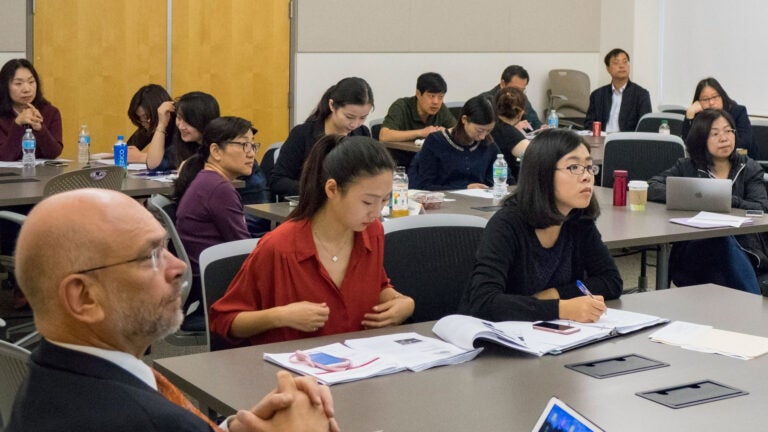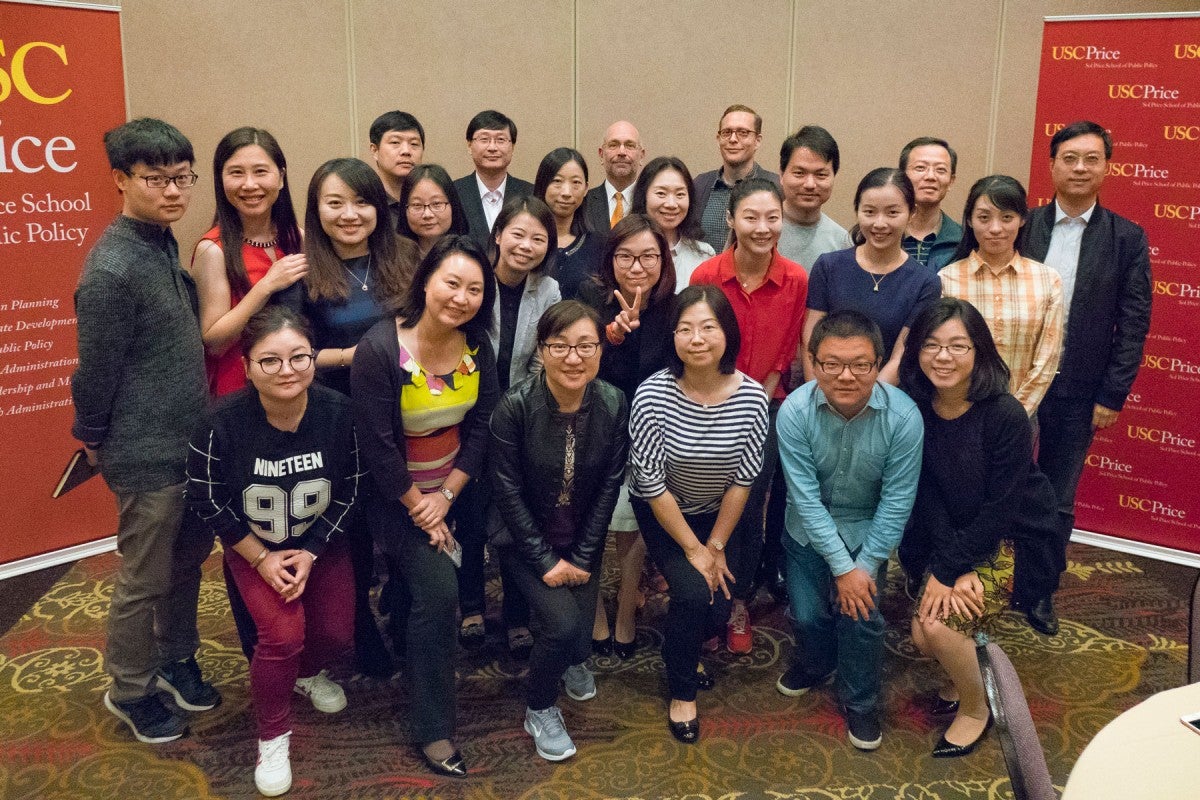
Shanghai officials listen to a lecture delivered by a USC faculty member. (Photo/Deirdre Flanagan)
Shanghai officials take part in USC Price cultural management program
Four weeks of training include lectures from USC faculty and visits to L.A. hotspots
How do the public and private sectors impact cultural institutions as diverse as the Getty and the Santa Monica Pier? That was one of the topics addressed during a four-week executive training program organized by the USC Price School of Public Policy for 19 public officials from the Shanghai Municipal Administration of Culture, Radio, Film and TV.
“The Shanghai municipal government is interested in applying principles of public-private partnerships toward the way it interacts with cultural and creative industries in Shanghai,” said Professor Eric Heikkila, director of international initiatives at USC Price.
Heikkila worked with Deputy Director Ginger Li and project coordinator Debby Hongdou Zhong from the Office of International Initiatives to organize the comprehensive training program, which combined lectures from USC faculty with meetings at major L.A. cultural institutions.
USC Price Dean Jack H. Knott delivered the welcome remarks for the delegation, and several Price faculty addressed topics at the intersection of public policy and cultural management during the program, which took place in L.A. and San Francisco.
Sharing interdisciplinary expertise, experiences
Professor Elizabeth Graddy, who is also the USC vice provost for academic and faculty affairs, delivered a lecture about public-private partnerships for public interests. As an experienced practitioner in this sphere, Professor Jane Pisano shared insights gleaned from her experience as former president of the Natural History Museum of Los Angeles County.
Professor Elizabeth Currid-Halkett moved the discussion into other cultural realms with a lecture on how fashion, art and music can contribute to economic development. Professor Robert Denhardt continued the theme of music in a lecture titled “The Dance of Leadership.”
Our discussion centered on the way that artistic concepts can be incorporated into one’s leadership style.
Robert Denhardt
“Our discussion centered on the way that artistic concepts such as rhythm and timing can be incorporated into one’s leadership style,” Denhardt said. “The session was especially exciting as we illustrated these concepts to some musical group ‘sing-alongs.’ Not the normal lecture, but it seemed to generate interest.”
The Chinese participants, who were also interested in Professor Shui Yan Tang’s 10 principles for a rule-ordered society, asked several thoughtful questions after the lecture.
“My talk covered some difficulties of applying these principles in the governing context of China and possible ways of overcoming these difficulties,” Tang said. “It was meant to help public managers in China improve their leadership and managerial effectiveness.”
Professor Terry Cooper offered another practical lecture about how to foster social capital and ethics in government.

“I have worked with Chinese officials for almost 30 years since living in Hong Kong as a Fulbright professor,” he said. “I feel a sense of commitment to assist them in any way that I can. My main field of public administration ethics is highly relevant to their struggle against corruption.”
The USC Annenberg School for Communication and Journalism also participated. Other university lecturers included Kenneth Foster from the USC Thornton School of Music, Jason E. Squire from the USC School of Cinematic Arts, Kevin Starr from the USC Dornsife College of Letters, Arts and Sciences and Christina Yu Yu from the USC Pacific Asia Museum. Their lectures touched on everything from communication policy to nonprofit arts funding to Hollywood.
“It was useful for our visitors from Shanghai to see the rich array of talent across campus, not just at the Price School,” Heikkila said.
Blending scholarship and practice
During the program’s many site visits, the participants ventured to key cultural hotspots such as the Sony lot, the Paramount lot, the Getty, the Los Angeles County Museum of Art, the Natural History Museum of Los Angeles County, the Music Center, the Los Angeles Convention Center and the Santa Monica Pier.
“I’m so grateful for the manner in which both our speakers from on campus and our partners off campus readily participated in this, and it really enriches the environment for the school as a whole,” Heikkila said. “It strengthens what are already fairly robust ties between our academic disciplines and related professional practice.”
This key combination of academics and professional practitioners impressed the Shanghai participants.
“The training program provides us with the cultural administrative concept, model and practice of the U.S. government through different lenses,” said Ruixian Yang, deputy division director of the marketing division of the Shanghai Municipal Administration of Culture, Radio, Film and TV.
Engaging directly with important government entities abroad has so much potential.
Eric Heikkila
Ye Wang, deputy manager of the Shanghai International Film Festival Center, also valued “the multidimensional combination of theoretical lectures and practical site visits.” She added, “The most valuable takeaway is that I have enhanced the knowledge and attained the methodology that can help improve my work back in China.”
The Chinese were not the only beneficiaries of the program, which was both an executive training and a valuable cultural exchange.
As Heikkila explained, “At the Price School, we think engaging directly with very important government entities abroad has so much potential. It enriches all of our understanding of what’s taking place in China. And when we turn around and go back into the classroom, it makes us better able to help connect students, their minds and their understanding to what’s going on around the world through this direct global engagement.”
